| Latest | Greatest | Lobby | Journals | Search | Options | Help | Login |
|
|
|
This topic is archived. |
| Home » Discuss » Topic Forums » Science |
|
| n2doc
|
Fri Jan-18-08 06:13 PM Original message |
| Friday Night Eye Candy-Mercury and more (Dialup warning) |
|
Friday Night Eye Candy: Gore Edition (Megabyte images Dialup alert)
Space  The Violent Lives of Galaxies: Caught in the Cosmic Dark Matter Web 01.10.08 Astronomers are using NASA�s Hubble Space Telescope to dissect one of the largest structures in the universe as part of a quest to understand the violent lives of galaxies. Hubble is providing indirect evidence of unseen dark matter tugging on galaxies in the crowded, rough-and-tumble environment of a massive supercluster of hundreds of galaxies. Dark matter is an invisible form of matter that accounts for most of the universe�s mass. Hubble�s Advanced Camera for Surveys has mapped the invisible dark matter scaffolding of the supercluster Abell 901/902, as well as the detailed structure of individual galaxies embedded in it. The image, taken by NASA�s Hubble Space Telescope, shows the supercluster. The red clumps throughout the image reveal the distribution of dark matter in the cluster. The galaxies lie within the clumps of dark matter. The image was assembled by combining a visible-light image of the supercluster taken with the MPG/ESO 2.2-meter telescope in La Silla, Chile, with a dark matter map derived from Hubble observations. Credit for the Hubble images: NASA, ESA, C. Heymans (University of British Columbia, Vancouver), M. Gray (University of Nottingham, U.K.), M. Barden (Innsbruck), and the STAGES collaboration 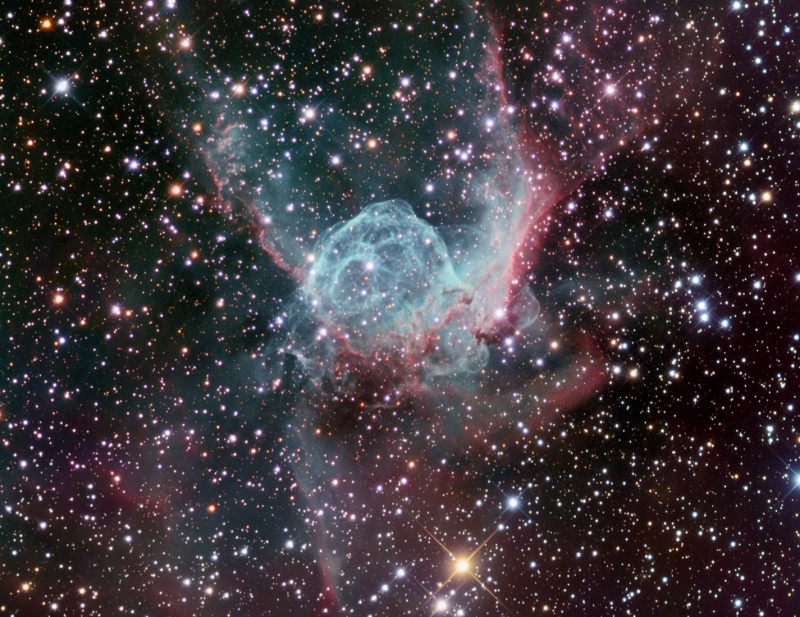 Thor's Emerald Helmet Credit & Copyright: Robert Gendler Explanation: This helmet-shaped cosmic cloud with wing-like appendages is popularly called Thor's Helmet. Heroically sized even for a Norse god, Thor's Helmet is about 30 light-years across. In fact, the helmet is actually more like an interstellar bubble, blown as a fast wind from the bright, massive star near the bubble's center sweeps through a surrounding molecular cloud. Known as a Wolf-Rayet star, the central star is an extremely hot giant thought to be in a brief, pre-supernova stage of evolution. Cataloged as NGC 2359, the nebula is located about 15,000 light-years away in the constellation Canis Major. The sharp image captures striking details of the nebula's filamentary structures and also records an almost emerald color from strong emission due to oxygen atoms in the glowing gas. 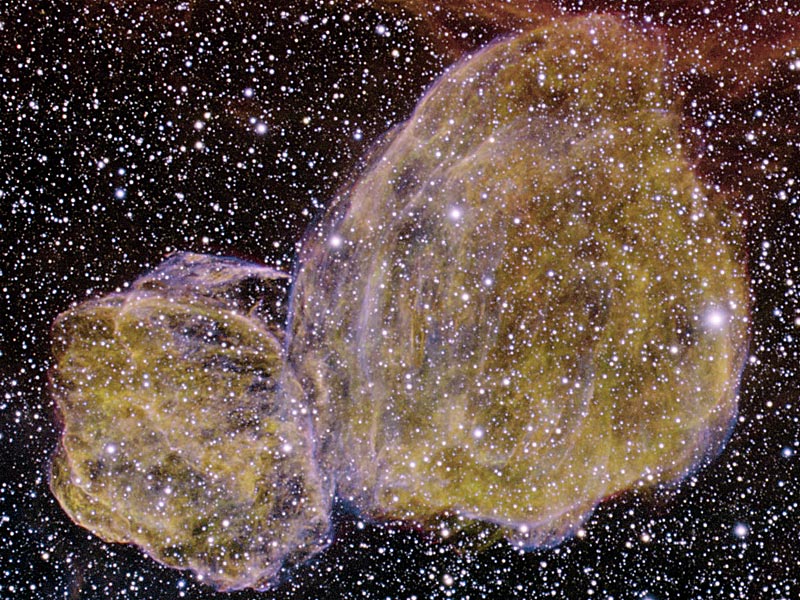 Double Supernova Remnants DEM L316 Credit & Copyright: Gemini Observatory, GMOS-South, NSF Explanation: Are these two supernova shells related? To help find out, the 8-meter Gemini Telescope located high atop a mountain in Chile was pointed at the unusual, huge, double-lobed cloud dubbed DEM L316. The resulting image, shown above, yields tremendous detail. Inspection of the image as well as data taken by the orbiting Chandra X-Ray Observatory indicate how different the two supernova remnants are. In particular, the smaller shell appears to be the result of Type Ia supernova where a white dwarf exploded, while the larger shell appears to be the result of a Type II supernova where a massive normal star exploded. Since those two stellar types evolve on such different time scales, they likely did not form together and so are likely not physically associated. Considering also that no evidence exists that the shells are colliding, the two shells are now hypothesized to be superposed by chance. DEM L316 lies about 160,000 light years away in the neighboring Large Magellanic Cloud (LMC) galaxy, spans about 140 light-years across, and appears toward the southern constellation of the Swordfish (Dorado). 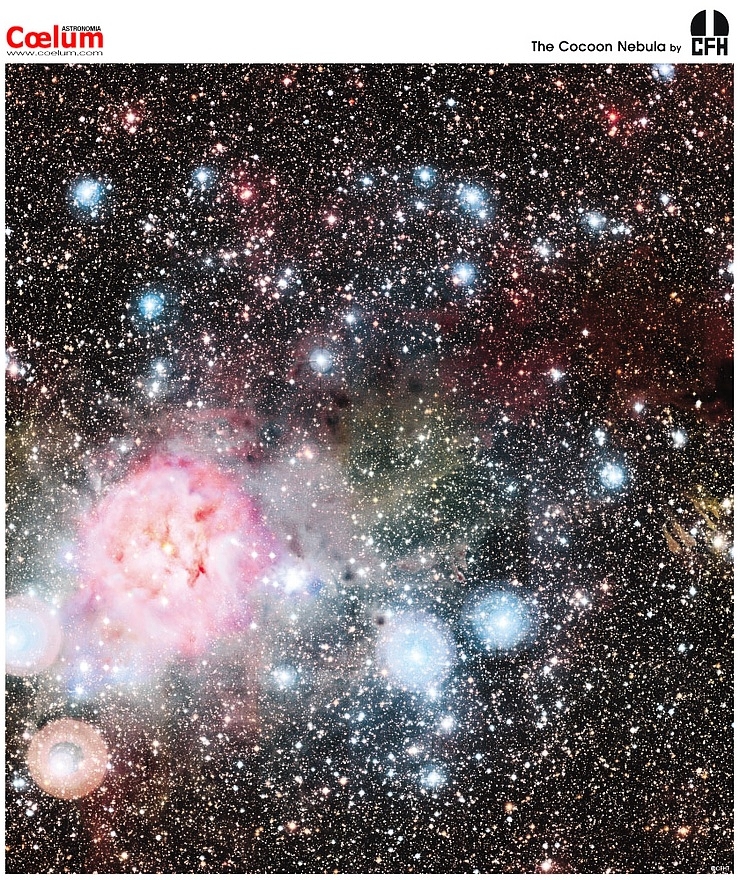 The Cocoon Nebula from CFHT Credit & Copyright: Jean-Charles Cuillandre (CFHT), Hawaiian Starlight, CFHT Explanation: What creates the colors of the Cocoon Nebula? The Cocoon Nebula, cataloged as IC 5146, is a strikingly beautiful nebula located about 4,000 light years away toward the constellation of the Swan (Cygnus). Inside the Cocoon Nebula is a newly developing open cluster of stars. Like other stellar nurseries, the Cocoon Nebula holds, at the same time, a bright red emission nebula, blue reflection nebulas, and dark absorption nebulas. Given different mixtures, these three processes create a host of colors in this image taken recently by the Canada-France-Hawaii Telescope (CFHT) in Hawaii, USA. Speculation based on recent measurements holds that the massive star towards the left of the picture opened a hole in an existing molecular cloud through which much of the glowing material flows. The same star, which formed about 100,000 years ago, now provides the energy source for much of the emitted and reflected light from this nebula.  The Milky Way at 5000 Meters Credit & Copyright: Serge Brunier Explanation: Climb up to 5000 meters (16,500 feet) above sea level, near Cerro Chajnantor in the northern Chilean Andes, and your night sky could encompass this cosmic vista. Recorded from that high and dry locale, the spectacular fish-eye image features the myriad stars and sprawling dust clouds of our Milky Way Galaxy. The direction toward the center of the Galaxy is near the zenith and center of the picture, but the Galactic Center itself is hidden from view, located far behind the obscuring dust. Brilliant Jupiter rules this scene just above the Milky Way's central bulge with the noticeably fainter, yellowish, giant star Antares to its right. Small and faint, near the right edge of the picture is one of the Milky Way's many satellite galaxies, the Small Magellanic Cloud. 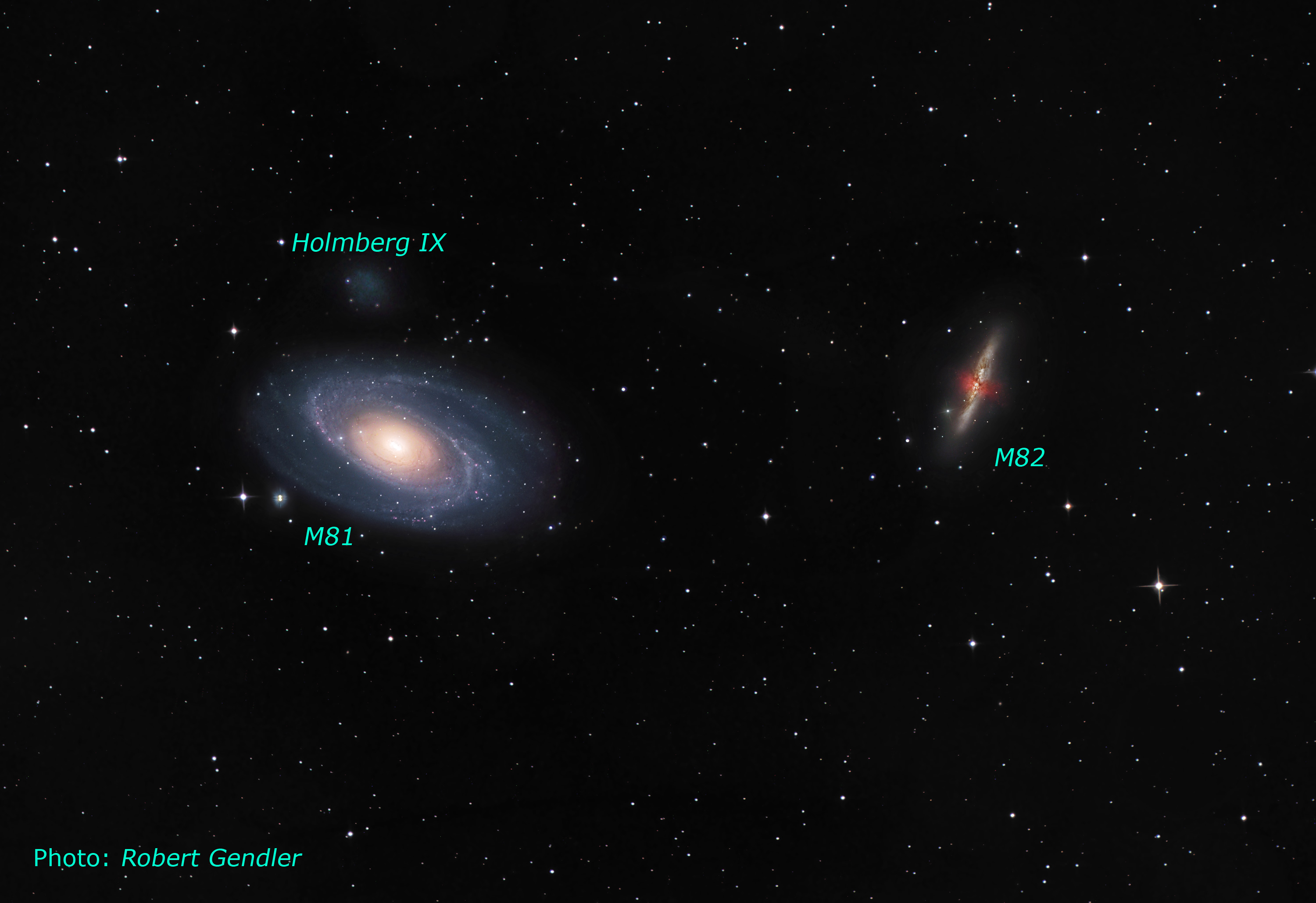 This wide-angle image taken by astrophotographer Robert Gendler shows the amazing duo of Messier 81 (right) and Messier 82 (left). These two galaxies in the Ursa Major constellation belong to some of the most famous and beloved galaxies known to amateur astronomers. Just above Messier 81 the dwarf galaxy Holmberg IX can be seen.   Study of 'GEMS' from Hubble, Spitzer Space Telescopes Reveals Cosmic Fireworks Fizzled Out at Universe Reached Mid-Life AUSTIN, Texas � We all start to party less around middle age, and new studies by a team led by University of Texas at Austin astronomer Shardha Jogee now finds that the universe, as a whole, is no exception. Jogee discussed her results today at a news conference at the 211th meeting of the American Astronomical Society. According to the current models of galaxy formation, dubbed �hierarchical lambda cold dark matter� models, galaxies built up to their current masses, shapes, and sizes through the successive mergers of less massive protogalaxies made of gas, stars, and dark matter. In the first quarter of the universe�s lifespan, the cosmic landscape was dominated by violent galaxy mergers, which could radically transform the shape of a galaxy and convert its gas into stars at an extreme rate. More than half of bright galaxies were indulging in such violent �partying.� New research is showing that all changed when the universe hit middle age. �Our study finds that over the last 7 billion years, after the universe hit its mid-forties, so to speak, it transitioned from a violent merger-driven mode into a quieter mode,� Jogee said. She and her team find that over each billion-year interval, only 10% of galaxies are typically involved in strong interactions and mergers. Jogee�s research team includes University of Texas at Austin students Sarah Miller and Kyle Penner, as well as her colleagues in the international GEMS collaboration, whose principal investigator is Hans-Walter Rix of the Max Planck Institute for Astronomy. Jogee�s team has analyzed more than 5,000 galaxies imaged by Hubble Space Telescope as part of GEMS, one of the largest-area surveys conducted with Hubble in two filters. More: http://mcdonaldobservatory.org/news/releases/2008/0109.html  Blue Blobs' in Space Are Orphaned Clusters of Stars 01.08.08 Hubble Space Telescope�s powerful vision has resolved strange objects nicknamed �blue blobs� and found them to be brilliant blue clusters of stars born in the swirls and eddies of a galactic smashup 200 million years ago. Such �blue blobs��weighing tens of thousands of solar masses�have never been seen in detail before in such sparse locations, say researchers. The �blue blobs� are found along a wispy bridge of gas strung among three colliding galaxies, M81, M82, and NGC 3077, residing about 12 million light-years away from Earth. This is not the place astronomers expect to find star clusters, because the gas filaments were considered too thin to accumulate enough material to actually build these many stars. The star clusters in this diffuse structure might have formed from gas collisions and subsequent turbulence, which enhanced locally the density of the gas streams. Galaxy collisions were much more frequent in the early universe, so �blue blobs� should have been common. After the stars burned out or exploded, the heavier elements forged in their nuclear furnaces would have been ejected to enrich intergalactic space.  ASA and Gemini Probe Mysterious Distant Explosion 01.08.08 When space-based satellites team up with large telescopes on the ground, they can be a powerful one-two combo for astronomical discovery. This is exactly what happened when astronomers used the giant Gemini North telescope in Hawaii to follow-up a discovery made with NASA�s Swift satellite. They found an incredibly powerful explosion halfway across the observable universe. Swift detected the explosion on July 14, 2007, as a bright flash of energy in the constellation Taurus. Because the explosion emits most of its energy in the form of gamma rays (an ultra-high-energy form of light), the explosion is called a gamma-ray burst, or GRB. And because the explosion only lasted for 3 seconds, it is known as a short GRB. Naturally enough, GRBs that last longer than 3 seconds are known as long GRBs. Astronomers have gathered very strong evidence that long GRBs are caused when massive stars explode. But they don�t actually know for certain what causes short GRBs. Astronomers think that most short GRBs are caused when two very dense but dead stars called neutron stars collide and merge, forming a black hole. The violent collision probably releases gamma rays in two jets that shoot away in opposite directions. After Swift detected the short GRB on July 14, a team of astronomers led by John Graham of the Johns Hopkins University in Baltimore, Md., aimed the Gemini North telescope at the location of the burst. The telescope revealed the galaxy where the GRB took place. By taking a spectrum of the galaxy and measuring its characteristics, they could determine the distance to the GRB: an astonishing 7.4 billion light-years. This means that the explosion occurred 7.4 billion years ago, which is before Earth even formed! 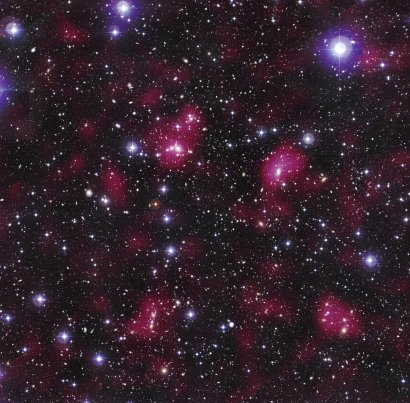 This image reveals the distribution of dark matter in the supercluster Abell 901/902, which is composed of hundreds of galaxies. The image shows the entire supercluster. Astronomers assembled this photo by combining a visible-light image of the supercluster taken with the MPG/ESO 2.2-metre telescope in La Silla, Chile, with a dark matter map derived from observations with the NASA/ESA Hubble Space Telescope. The magenta-tinted clumps represent a map of the dark matter in the cluster. Dark matter is an invisible form of matter that accounts for most of the Universe's mass. The image shows that the supercluster galaxies lie within the clumps of dark matter. Hubble cannot see the dark matter directly. Astronomers inferred its location by analyzing the effect of weak gravitational lensing, where light from more than 60 000 galaxies behind Abell 901/902 is distorted by intervening matter within the cluster. Researchers used the observed, subtle distortion of the galaxies' shapes to reconstruct the dark matter distribution in the supercluster. The image is part of the Space Telescope Abell 901/902 Galaxy Evolution Survey (STAGES), which covers one of the largest patches of sky ever observed by the Hubble telescope. The area surveyed is so wide that it took 80 Hubble images to cover the entire field, measuring about 0.5��0.5� on the sky. Hubble's Advanced Camera for Surveys made the observations in June and July 2005 and in January 2006.  NEW BRUNSWICK, N.J. � Astronomers at Rutgers and Penn State universities have discovered galaxies in the distant universe that are ancestors of spiral galaxies like our Milky Way. These ancient objects, some of the first galaxies ever to form, are being observed as they looked when the universe was a mere two billion years old. Today, scientists peg the universe�s age at 13.7 billion years, so light from these galaxies traveled almost 12 billion years to reach Earth. The newly discovered galaxies are quite small � one-tenth the size and one-twentieth the mass of our Milky Way. They also have fewer stars � only one-fortieth as many as are in the Milky Way. From ground-based telescopes, they look like individual stars in size. Recent images made by the Hubble Space Telescope, however, reveal them as regions of active star formation. �Finding these objects and discovering that they are a step in the evolution of our galaxy is akin to finding a key fossil in the path of human evolution,� said Eric Gawiser, assistant professor in the Department of Physics and Astronomy in the Rutgers School of Arts and Sciences. He presented findings from teams led by him and Caryl Gronwall, senior research associate in Penn State�s Department of Astronomy & Astrophysics, at the American Astronomical Society (AAS) annual meeting January 7-11, 2008 in Austin, Texas. More: http://ur.rutgers.edu/medrel/viewArticle.html?ArticleID=6112  Galaxies of All Shapes and Sizes This artist's concept illustrates the two types of spiral galaxies that populate our universe: those with plump middles, or central bulges (upper left), and those without them (foreground).??New observations from NASA's Spitzer Space Telescope provide strong evidence that the slender, bulgeless galaxies can, like their chubbier counterparts, harbor supermassive black holes at their cores. Previously, astronomers thought that a galaxy without a bulge could not have a supermassive black hole. The findings are reshaping theories of galaxy formation.??Image Credit: NASA/JPL-Caltech ?  Jet Power Jet PowerThis dramatic image of the nearby galaxy Centaurus A provides one of the best views to date of the effects of an active supermassive black hole. Opposing jets of high-energy particles can be seen extending to the outer reaches of the galaxy, and numerous smaller black holes in binary star systems are also visible. ??The image obtained via an ultra-deep look at the galaxy by the Chandra X-Ray Observatory that was equivalent to more than seven days of continuous observations. Centaurus A is the nearest galaxy to Earth that contains a supermassive black hole actively powering a jet. ??A prominent X-ray jet extending for 13,000 light years points to the upper left in the image, with a shorter "counterjet" aimed in the opposite direction. Astronomers think that such jets are important vehicles for transporting energy from the black hole to the much larger dimensions of a galaxy, and affecting the rate at which stars form there.??Image Credit: NASA/CXC/CfA/R. Kraft et al.? Sun  movie: http://earthobservatory.nasa.gov/Newsroom/NewImages/Images/sunspot_10891_low.mov NASA and European Space Agency satellite images have captured the appearance of the first sunspot of the new solar cycle. Sunspots are areas of intense magnetic activity that are visible on the surface of the Sun as dark spots. Sunspot activity rises and falls on a roughly 11-year cycle. The previous solar cycle peaked between 2000 and 2002. Even as scientists kept an eye on the sunspot �stragglers� of waning Solar Cycle 23 in late 2007, they were also on the lookout for the first sunspot that would signal the start of Solar Cycle 24. On January 4, 2008, the new sunspot�about the width of the Earth, but small by Sun standards�appeared in the Sun�s Northern Hemisphere, with its north magnetic pole (red area) pointing to the right and its south magnetic pole (blue) pointing to the left. The image was captured by the Solar and Heliospheric Observatory satellite. The sunspot lasted until January 6 before fading away. The animations above show activity between January 1-14. The position of the magnetic poles in sunspot 10981 was one of the ways scientists knew it was part of a new cycle. Within any particular cycle, the sunspots in each hemisphere will have opposite polarity, and the polarity for each hemisphere reverses from cycle to cycle. Since the large sunspot area in the Southern Hemisphere from Solar Cycle 23 (number 10980, shown in the left-hand part of the image) is also oriented with its north pole at right and south pole at left, the new one that appeared in the Northern Hemisphere on January 4 must be part of a different solar cycle. More: http://earthobservatory.nasa.gov/Newsroom/NewImages/images.php3?img_id=17895  Hubble Finds Rare Double Ring in Space 01.10.08 The Hubble Space Telescope has revealed a never-before-seen optical alignment in space: a pair of glowing rings, one nestled inside the other like a bull�s-eye pattern. The double-ring pattern is caused by the complex bending of light from two distant galaxies strung directly behind a foreground massive galaxy, like three beads on a string. This very rare phenomenon can offer insight into dark matter, dark energy, the nature of distant galaxies, and even the curvature of the universe. The phenomenon, called gravitational lensing, occurs when a massive galaxy in the foreground bends the light rays from a distant galaxy behind it, in much the same way as a magnifying glass would. When both galaxies are exactly lined up, the light forms a circle, called an �Einstein ring,� around the foreground galaxy. If another background galaxy lies precisely on the same sightline, a second, larger ring will appear. The massive foreground galaxy is almost perfectly aligned in the sky with two background galaxies at different distances. The foreground galaxy is 3 billion light-years away. The inner ring and outer ring are comprised of multiple images of two galaxies at a distance of 6 billion and approximately 11 billion light-years. The odds of seeing such a special alignment are estimated to be 1 in 10,000.  ircumstellar Dust Takes Flight in 'The Moth' 01.10.08 What superficially resembles a giant moth floating in space is giving astronomers new insight into the formation and evolution of planetary systems. This is not your typical flying insect. It has a wingspan of about 22 billion miles. The wing-like structure is actually a dust disk encircling the nearby, young star HD 61005, dubbed "The Moth." Its shape is produced by starlight scattering off dust. Dust disks around roughly 100-million-year-old stars like HD 61005 are typically flat, pancake-shaped structures where planets can form. But images taken with NASA's Hubble Space Telescope of "The Moth" are showing that some disks sport surprising shapes. The Hubble image was taken with the Near-Infrared Camera and Multi-Object Spectrometer (NICMOS). The black disk in the center of the image is a coronagraphic hole in the NICMOS camera that blocks out most of the central star's light so that astronomers can see details in the surrounding dust disk. Saturn  Flowing Liquids on Titan 01.08.07 This synthetic aperture radar image was obtained by the Cassini spacecraft on its pass by Titan's south pole on Dec. 20, 2007. This image is centered near 76.5 south, 32.5 west and covers an area of 620 kilometers by 270 kilometers (385 miles by 170 miles). Abundant evidence for flowing liquids is seen in this image, from sinuous, wide river channels to shorter, more chaotic drainage patterns. The extremely dissected, rugged terrain in the southern portion of the image has been very eroded by flowing liquids, probably from a combination of methane rainstorms and sapping (subsurface methane rising to erode the surface). The broad valleys seen in the southern portion of the image are particularly intriguing, as they appear to be flat-floored, filled with smooth material, and in places have sharply defined, relatively straight sides. Valleys such as this can be formed by tectonic processes, such as rifting, or by erosional processes, caused by flowing liquid or ice. The Cassini-Huygens mission is a cooperative project of NASA, the European Space Agency and the Italian Space Agency. NASA's Jet Propulsion Laboratory, a division of the California Institute of Technology in Pasadena, manages the mission for NASA's Science Mission Directorate, Washington, D.C. The Cassini orbiter was designed, developed and assembled at JPL. The radar instrument was built by JPL and the Italian Space Agency, working with team members from the United States and several European countries. Mars  A Happy 4th! NASA'S Mars Exploration Rover Spirit captured this westward view from atop a low plateau where it spent the closing months of 2007.??With its daily solar-energy supply shrinking as Martian summer turned to fall, Spirit drove to the northern edge of the plateau called "Home Plate" for a favorable winter haven. The rover reached that northward-tilting site in December, in time for the fourth Earth-year anniversary of its landing on Mars. Spirit reached Mars on Jan. 4, 2004, Universal Time (Jan. 3, 2004, PST). ??This panorama covers a scene spanning left to right from southwest to northeast. The western edge of Home Plate is in the foreground, generally lighter in tone than the more distant parts of the scene. A rock-dotted hill in the middle distance across the left third of the image is "Tsiolkovski Ridge," about 30 meters or 100 feet from the edge of Home Plate and about that same distance across. A bump on the horizon above the left edge of Tsiolkovski Ridge is "Grissom Hill," about 8 kilometers or 5 miles away. At right, the highest point of the horizon is "Husband Hill," to the north and about 800 meters or half a mile away. ??Spirit was perched near the western edge of Home Plate when it used its panoramic camera (Pancam) to take the images used in this view. This view combines separate images taken through Pancam filters centered on wavelengths of 753 nanometers, 535 nanometers and 432 nanometers and is presented in a false-color stretch to bring out subtle color differences in the scene. ??Image Credit: NASA/JPL-Caltech/Cornell University  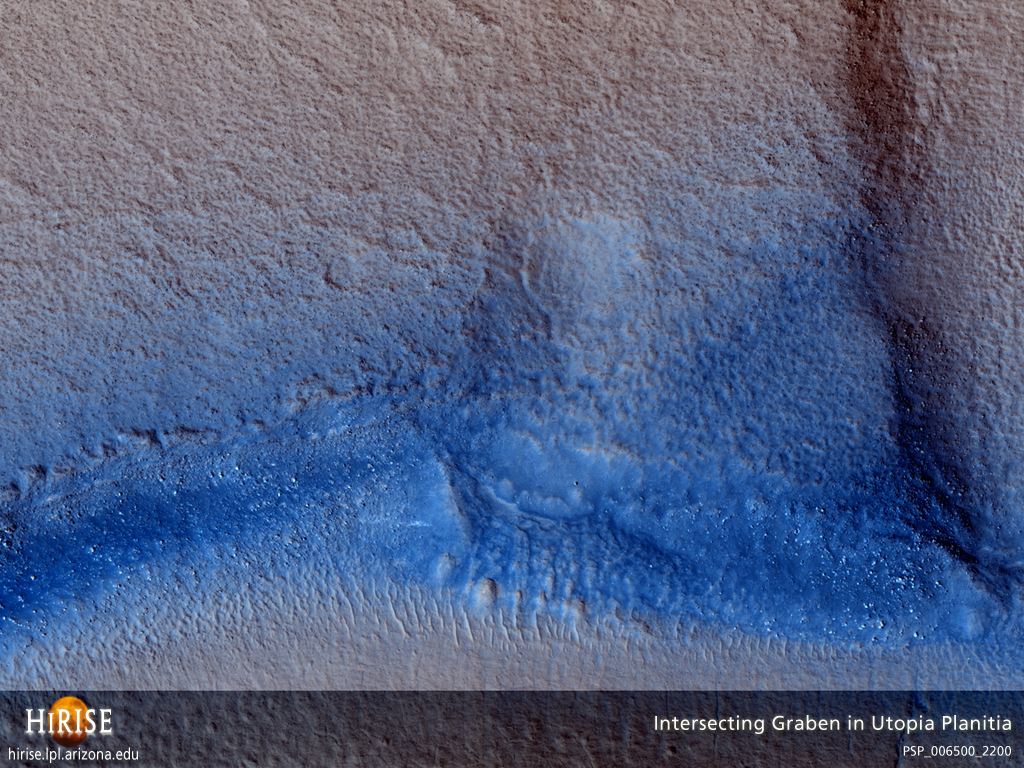 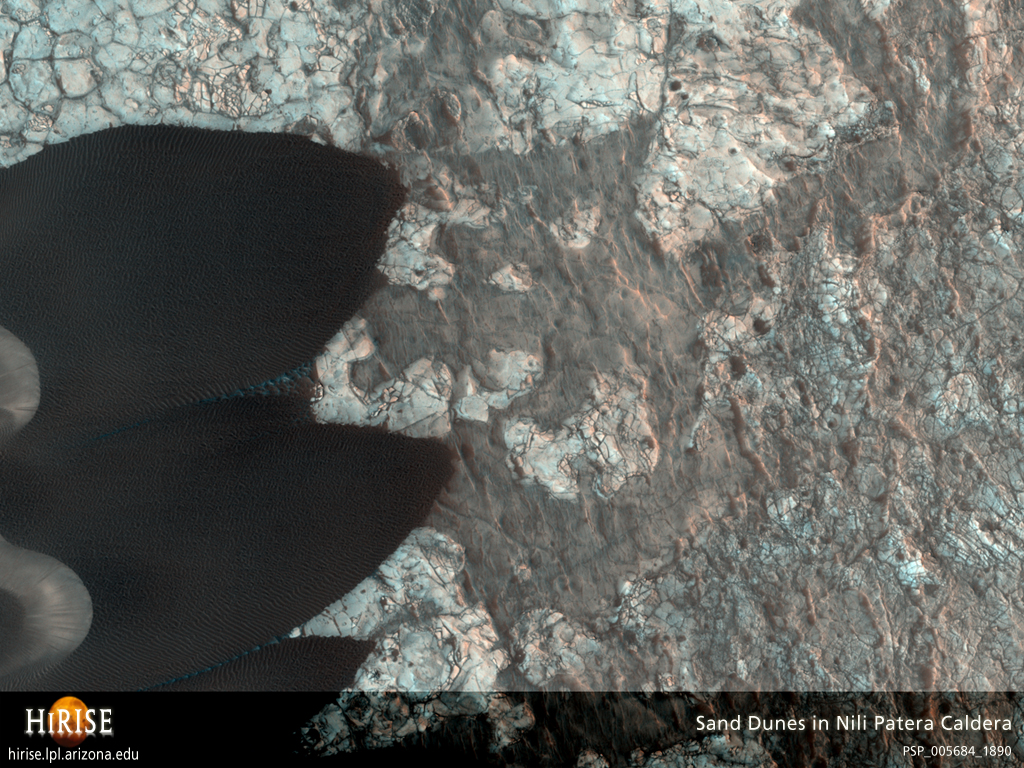  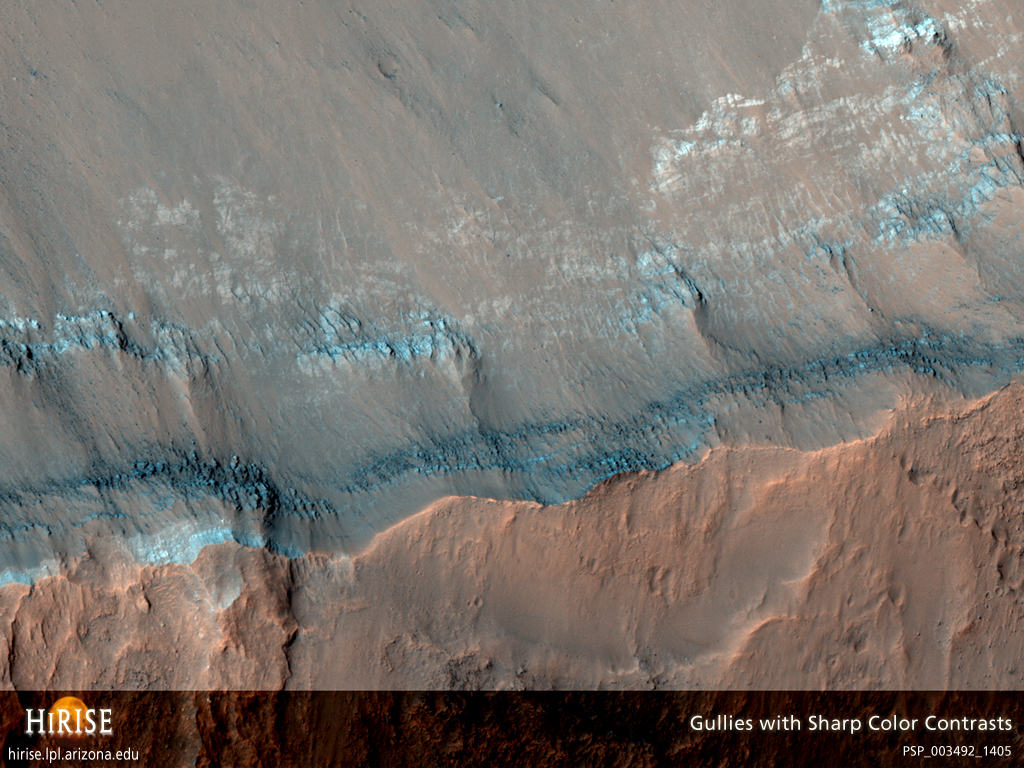 This image shows a southern mid-latitude crater: it has bright landslides on its southeast and west walls, some of which have noticeable boulder tracks where boulders rolled down the slopes.??The most noticeable features of this crater are the gullies on the north wall. A couple of small gullies appear to emanate from an overhang. The others originate at or near layers up-slope. The layers are sturdy and resistant from erosion: the layers that appear to be decaying into resolvable boulders, instead of particles easily moved by the wind, are evidence of this.??The color portion of this observation is spectacular. Note the distinct, blue layers lining the south rim of the crater and the white-blue rocks poking through. Wind erosion will likely expose them as time continues.??The top part of the image captures the complex floor of a larger crater upon which the featured crater is superposed. There are a large number of dunes as well as prominent ridges. The color contrast of the gullies to their surroundings is quite distinct. The gullies have blue channels; however, their down-slope debris aprons are redder. This probably indicates a change in particle size, or that the debris aprons have been covered with dust to blend into their surroundings.??Please note that this image is false color; it is not as it would appear naturally to the human eye. Movie: http://hirise.lpl.arizona.edu/media/clips/PSP_003086_2015_short.mov Mercury  MESSENGER's first view of Mercury MESSENGER snapped this image of a crescent Mercury on January 9 when it was about 2.7 million kilometers from the planet. Credit: NASA / JHUAPL / CIW  Shortly following MESSENGER�s closest approach to Mercury on January 14, 2008, the spacecraft�s Narrow Angle Camera (NAC) on the Mercury Dual Imaging System (MDIS) instrument acquired this image as part of a mosaic that covers much of the sunlit portion of the hemisphere not viewed by Mariner 10. Images such as this one can be read in terms of a sequence of geological events and provide insight into the relative timing of processes that have acted on Mercury's surface in the past. The double-ringed crater pictured in the lower left of this image appears to be filled with smooth plains material, perhaps volcanic in nature. This crater was subsequently disrupted by the formation of a prominent scarp (cliff), the surface expression of a major crustal fault system, that runs alongside part of its northern rim and may have led to the uplift seen across a portion of the crater�s floor. A smaller crater in the lower right of the image has also been cut by the scarp, showing that the fault beneath the scarp was active after both of these craters had formed. The MESSENGER team is working to combine inferences about the timing of events gained from this image with similar information from the hundreds of other images acquired by MESSENGER to extend and refine the geological history of Mercury previously defined on the basis only of Mariner 10 images.  New View Named by the Romans after the fleet-footed messenger of the gods, the planet Mercury is closest to the sun. Seen here by NASA's MESSENGER spacecraft on Jan. 14, 2008, this observation was the first of its kind since the planet was glimpsed by Mariner 10 more than three decades ago.??Messenger captured this view of the planet's rugged, cratered landscape illuminated obliquely by the sun. This image was taken from a distance of approximately 11,000 miles, about 56 minutes before the spacecraft's closest encounter with Mercury. It shows a region 300 miles across including craters less than a mile wide.  As the MESSENGER spacecraft drew closer to Mercury for its historic first flyby, the spacecraft�s Narrow Angle Camera (NAC) on the Mercury Dual Imaging System (MDIS) acquired an image mosaic of the sunlit portion of the planet. This image is one of those mosaic frames and was acquired on January 14, 2008, 18:10 UTC, when the spacecraft was about 18,000 kilometers (11,000 miles) from the surface of Mercury, about 55 minutes before MESSENGER�s closest approach to the planet. The image shows a variety of surface textures, including smooth plains at the center of the image, many impact craters (some with central peaks), and rough material that appears to have been ejected from the large crater to the lower right. This large 200-kilometer-wide (about 120 miles) crater was seen in less detail by Mariner 10 more than three decades ago and was named Sholem Aleichem for the Yiddish writer. In this MESSENGER image, it can be seen that the plains deposits filling the crater�s interior have been deformed by linear ridges. The shadowed area on the right of the image is the day-night boundary, known as the terminator. Altogether, MESSENGER acquired over 1200 images of Mercury, which the science team members are now examining in detail to learn about the history and evolution of the innermost planet.  When Mariner 10 flew past Mercury three times in 1974 and 1975, the same hemisphere was in sunlight during each encounter. As a consequence, Mariner 10 was able to image less than half the planet. Planetary scientists have wondered for more than 30 years about what spacecraft images might reveal about the hemisphere of Mercury that Mariner 10 never viewed. On January 14, 2008, the MESSENGER spacecraft observed about half of the hemisphere missed by Mariner 10. This image was snapped by the Wide Angle Camera, part of the Mercury Dual Imaging System (MDIS) instrument, about 80 minutes after MESSENGER's closest approach to Mercury (2:04 pm EST), when the spacecraft was at a distance of about 27,000 kilometers (about 17,000 miles). The image shows features as small as 10 kilometers (6 miles) in size. This image was taken through a filter sensitive to light near the red end of the visible spectrum (750 nm), one of a sequence of images taken through each of MDIS�s 11 filters. Like the previously mapped portion of Mercury, this hemisphere appears heavily cratered. It also reveals some unique and distinctive features. On the upper right is the giant Caloris basin, including its western portions never before seen by spacecraft. Formed by the impact of a large asteroid or comet, Caloris is one of the largest, and perhaps one of the youngest, basins in the Solar System. The new image shows the complete basin interior and reveals that it is brighter than the surrounding regions and may therefore have a different composition. Darker smooth plains completely surround Caloris, and many unusual dark-rimmed craters are observed inside the basin. Several other multi-ringed basins are seen in this image for the first time. Prominent fault scarps (large ridges) lace the newly viewed region. Movie of approach http://messenger.jhuapl.edu/the_mission/movies/opnav_jan09_jan13.mov Earth  Morenci Looking more like an alien landscape than an Earthly landscape, the Morenci open-pit copper mine in southeast Arizona is North America�s leading producer of copper. ??In the 1860s, prospectors arrived looking for gold; instead they found copper. Underground mining began in the 1870s, and the first pit was opened in 1939. Phelps Dodge employs over 200 people in the mining and refining operations. Around-the-clock removal of 700,000 tons of rock per day results in production of 382,000 tons of copper per year. ??This ASTER image uses shortwavelength infrared bands to highlight in bright pink the altered rocks in the Morenci pit associated with copper mineralization. ?  La Nina Still Going in January 2008 ?? La Ni�a conditions often follow El Ni�o in the cycle known as the El Ni�o/Southern Oscillation (ENSO). La Ni�a episodes are marked by stronger-than-normal easterly trade winds and below-normal sea surface temperatures in the eastern tropical Pacific Ocean. These changes in ocean temperature and atmospheric circulation have worldwide implications for weather patterns. La Ni�a conditions appeared in February 2007 and strengthened in October and November. La Ni�a conditions often peak in January, as they appeared to do in January 2008. This image shows the temperature anomaly for the top millimeter of the Pacific Ocean�s surface�the skin temperature�on January 14, 2008, based on data from the Advanced Microwave Scanning Radiometer (AMSR-E) flying on NASA�s Aqua satellite. In this image, January 14, 2008, temperatures are compared to the long-term average measured by a series of sensors that flew on NOAA Pathfinder satellites from 1985 to 1997. A strong band of blue (cool) water appears along the Equator, fanning out near North and South America. Patches of orange to red (warm) conditions appear north and south of this strong blue band. As of January 2008, the U.S. National Oceanic and Atmospheric Administration (NOAA) predicted that La Ni�a conditions would continue until spring, with a possible weakening in February 2008. Cool ocean temperatures can impede cloud growth, leading to reduced rainfall from South America to Indonesia. In the continental United States, La Ni�a affects the jet stream, which in turn affects weather. Typical La Ni�a winter weather patterns include very cool, wet conditions in the Pacific Northwest, especially cold winter conditions on the Great Plains, and unusually dry conditions in the Southwest and Southeast. Because La Ni�a conditions can persist for years, such adverse weather conditions can continue. In short, continued La Ni�a conditions were expected to prolong the droughts in the American Southeast and Southwest.  The Caspian Sea and the surrounding landscape were swathed in winter white on January 10, 2008, when this image was captured by the Moderate Resolution Imaging Spectroradiometer (MODIS) on NASA�s Terra satellite. A thin layer of snow covered the ground in Russia and Kazakhstan; the Volga River and its distributaries were white ribbons; and a rim of solid ice clung to the shoreline. The northern part of the sea is more likely to freeze than the southern for several reasons: it is shallower, it experiences a more continental climate (colder winter), and it is less salty.  Meteors and Aurora Where do meteor showers originate? To help answer this question, astronomers studied his past weekend's Quadrantid meteor shower. In particular, astronomers with specialized cameras flew as part of the Quadrantid's Multi-Instrument Aircraft Campaign (MAC) aboard a NASA DC-8 aircraft above northern Canada and studied the meteor shower in unprecedented detail. Pictured above is a composite image combining many short exposures. ??Visible in the image are the tail of the airplane reflecting a red beacon on the left, green aurora most prominent on the image right, and numerous meteor streaks throughout. Preliminary indications are that the meteor stream is quite stable in time. Over 100 meteors per hour were visible at the shower's peak from the MAC aircraft. ??Image Credit: NASA, Caltech, Jeremie Vaubaillon et al. |
| Printer Friendly | Permalink | | Top |
| Xipe Totec
|
Fri Jan-18-08 06:22 PM Response to Original message |
| 1. Neat stuff! |
|
Thanks! :hi:
|
| Printer Friendly | Permalink | | Top |
| freethought
|
Sat Jan-19-08 01:02 AM Response to Original message |
| 2. LOVE THE PHOTOS OF MARS! |
|
Wow! It's almost hard to tell the difference between Mercury and the Moon!!
|
| Printer Friendly | Permalink | | Top |
| qazplm
|
Sat Jan-19-08 12:57 PM Response to Original message |
| 3. Pegasus Dwarf Galaxy |
|
got anything on that? :)
|
| Printer Friendly | Permalink | | Top |
| krispos42
|
Sun Jan-20-08 01:06 AM Response to Original message |
| 4. Can't rec.. |
|
so I'll kick.
Awesome... <sign> sometimes I wish I'd been born in the Quadcentennial instead of the Bicentennial... |
| Printer Friendly | Permalink | | Top |
| DU
AdBot (1000+ posts) |
Fri Apr 19th 2024, 05:26 PM Response to Original message |
| Advertisements [?] |
| Top |
| Home » Discuss » Topic Forums » Science |
|
Powered by DCForum+ Version 1.1 Copyright 1997-2002 DCScripts.com
Software has been extensively modified by the DU administrators
Important Notices: By participating on this discussion board, visitors agree to abide by the rules outlined on our Rules page. Messages posted on the Democratic Underground Discussion Forums are the opinions of the individuals who post them, and do not necessarily represent the opinions of Democratic Underground, LLC.
Home | Discussion Forums | Journals | Store | Donate
About DU | Contact Us | Privacy Policy
Got a message for Democratic Underground? Click here to send us a message.
© 2001 - 2011 Democratic Underground, LLC